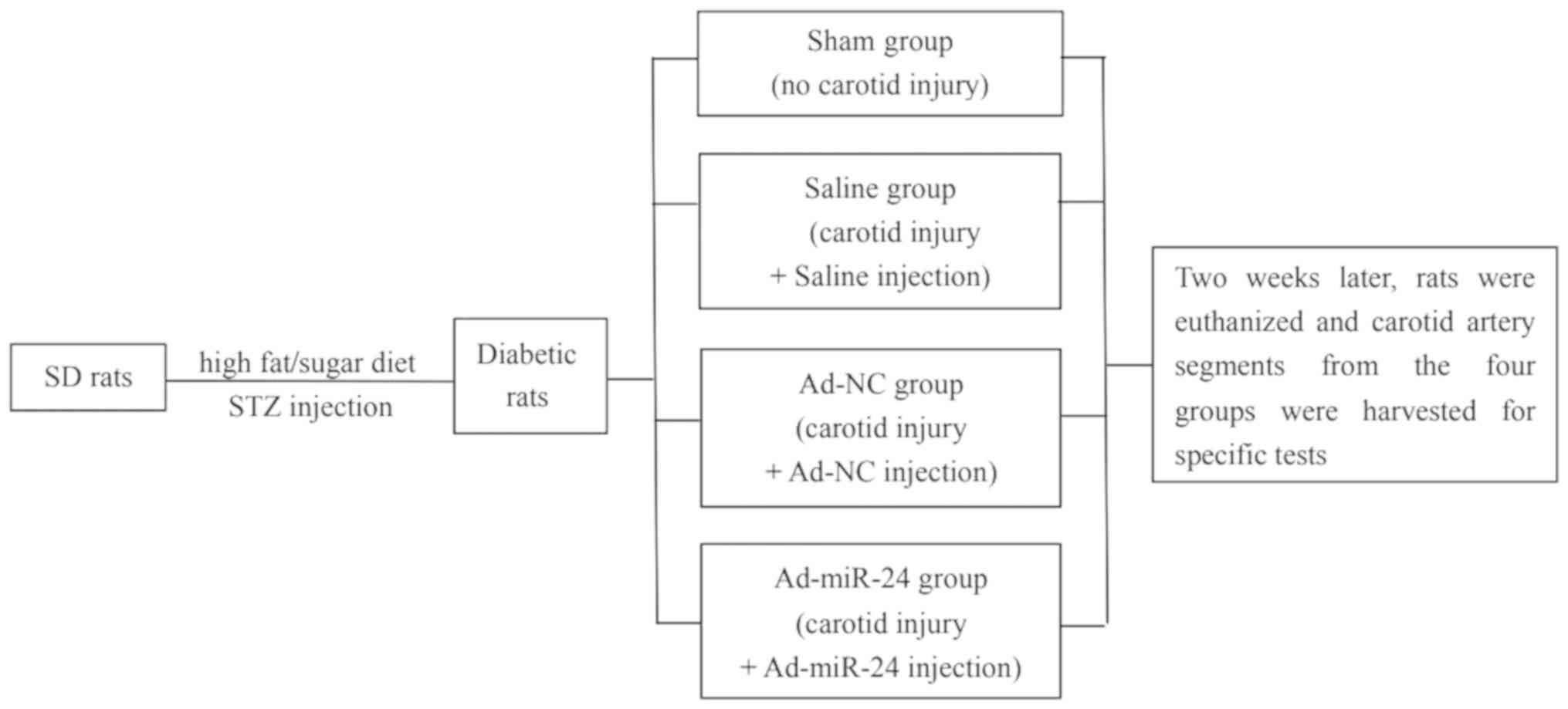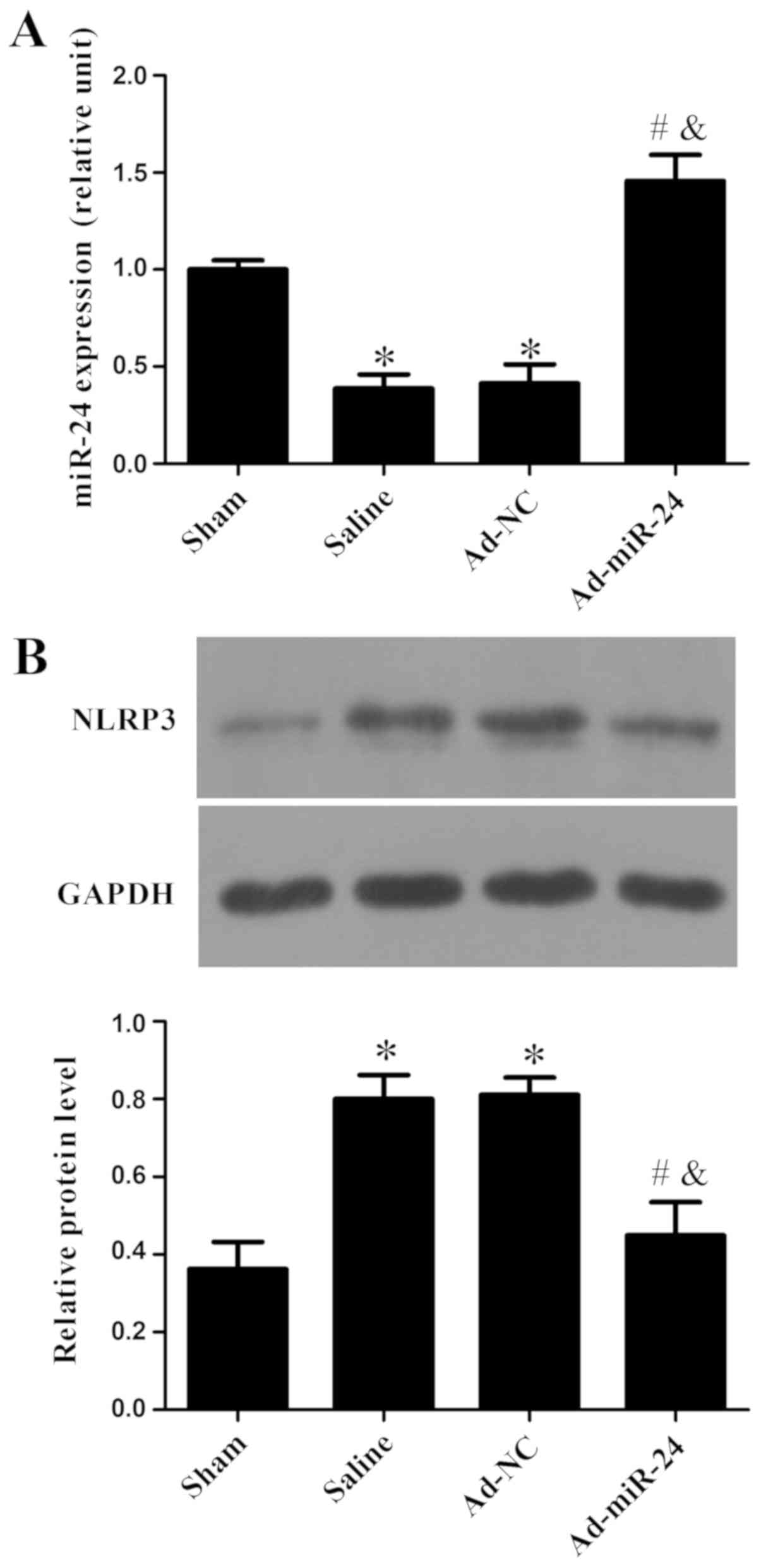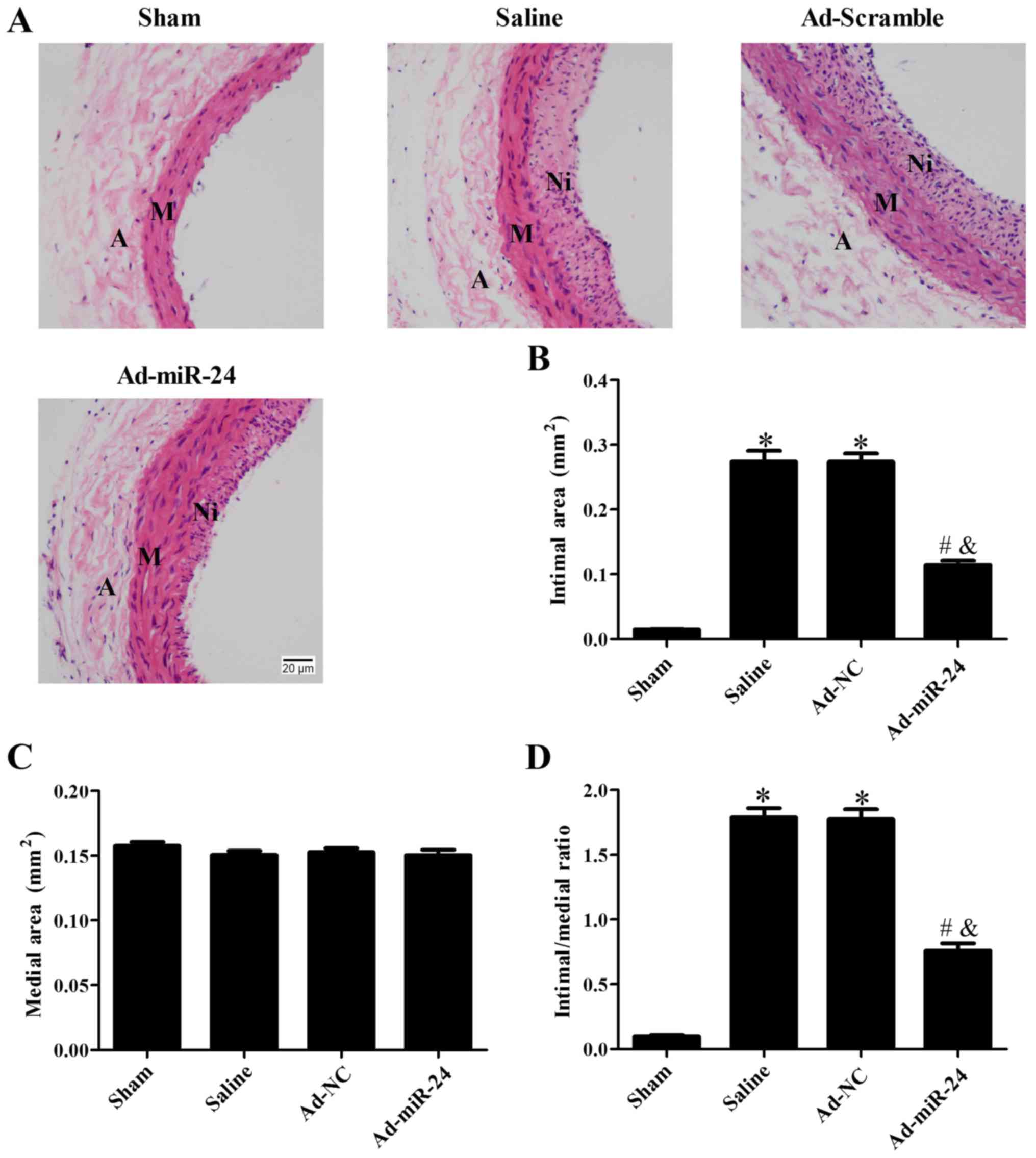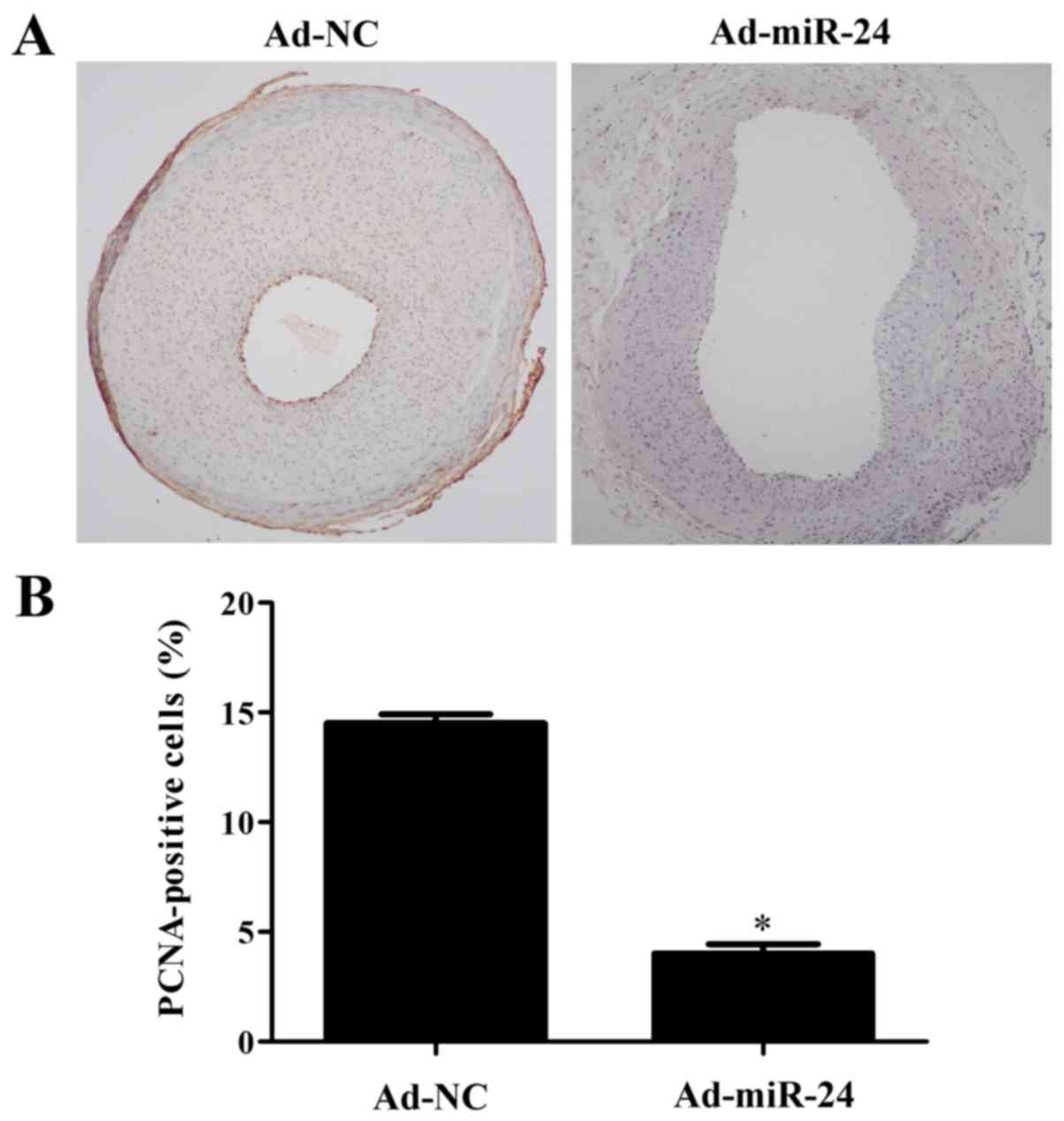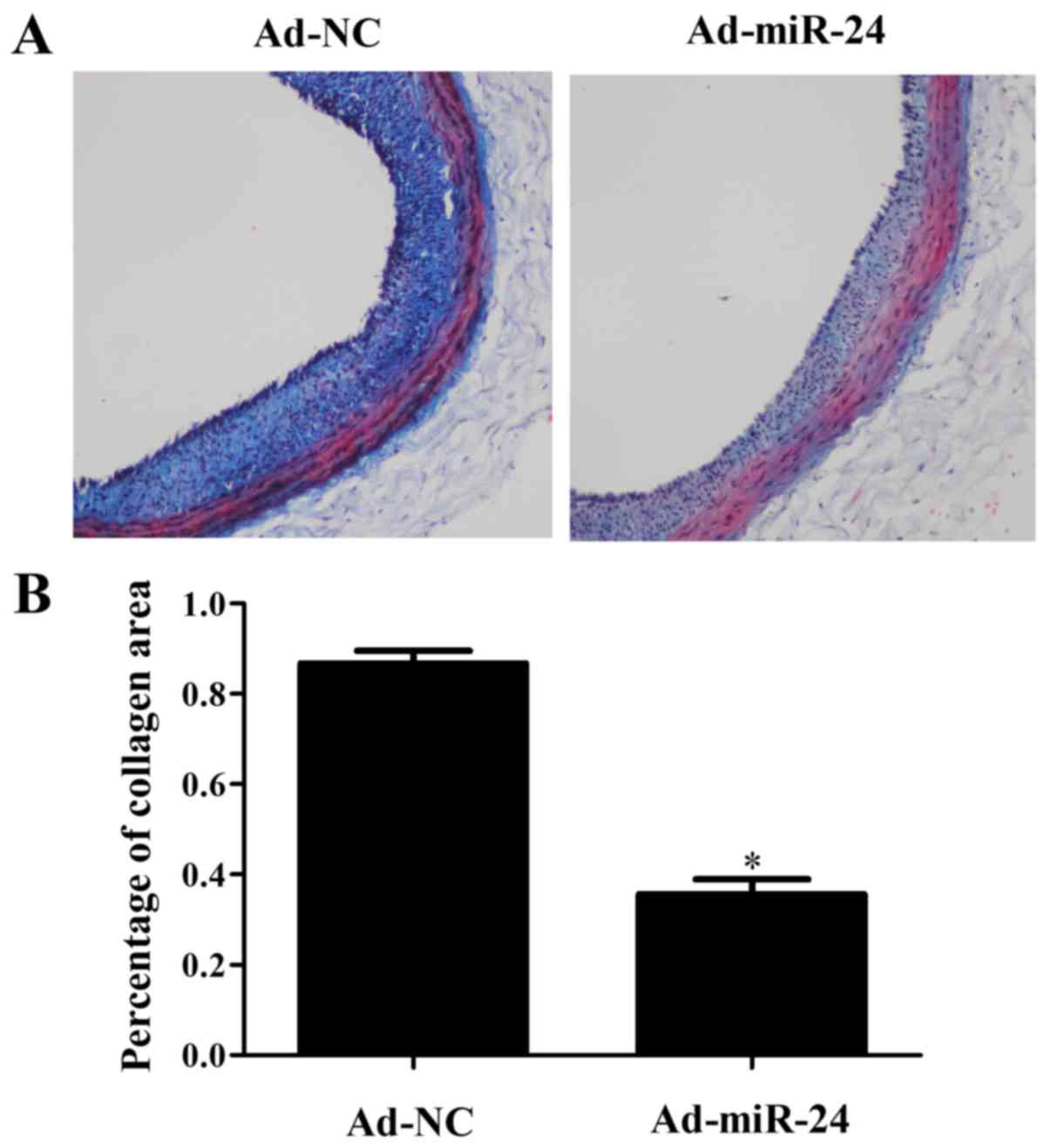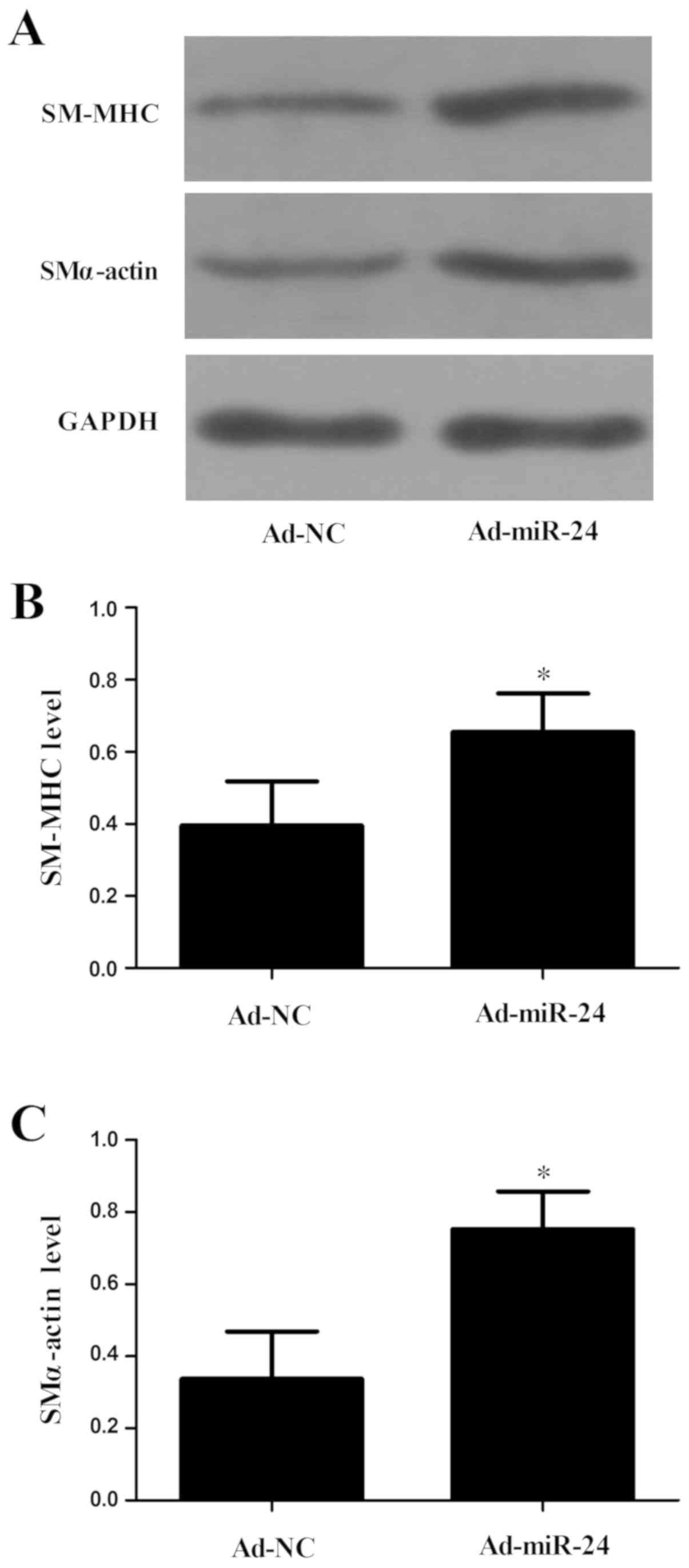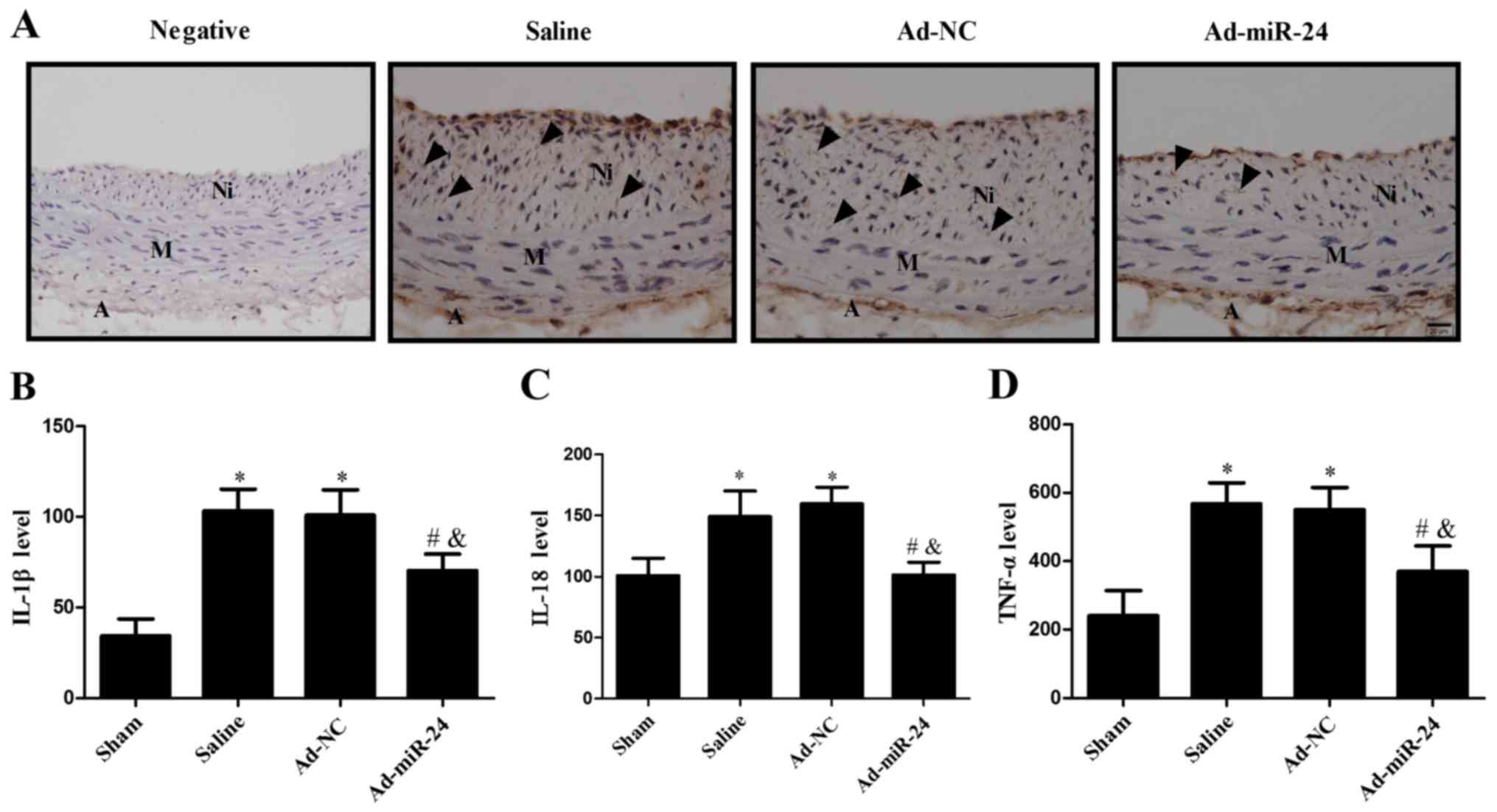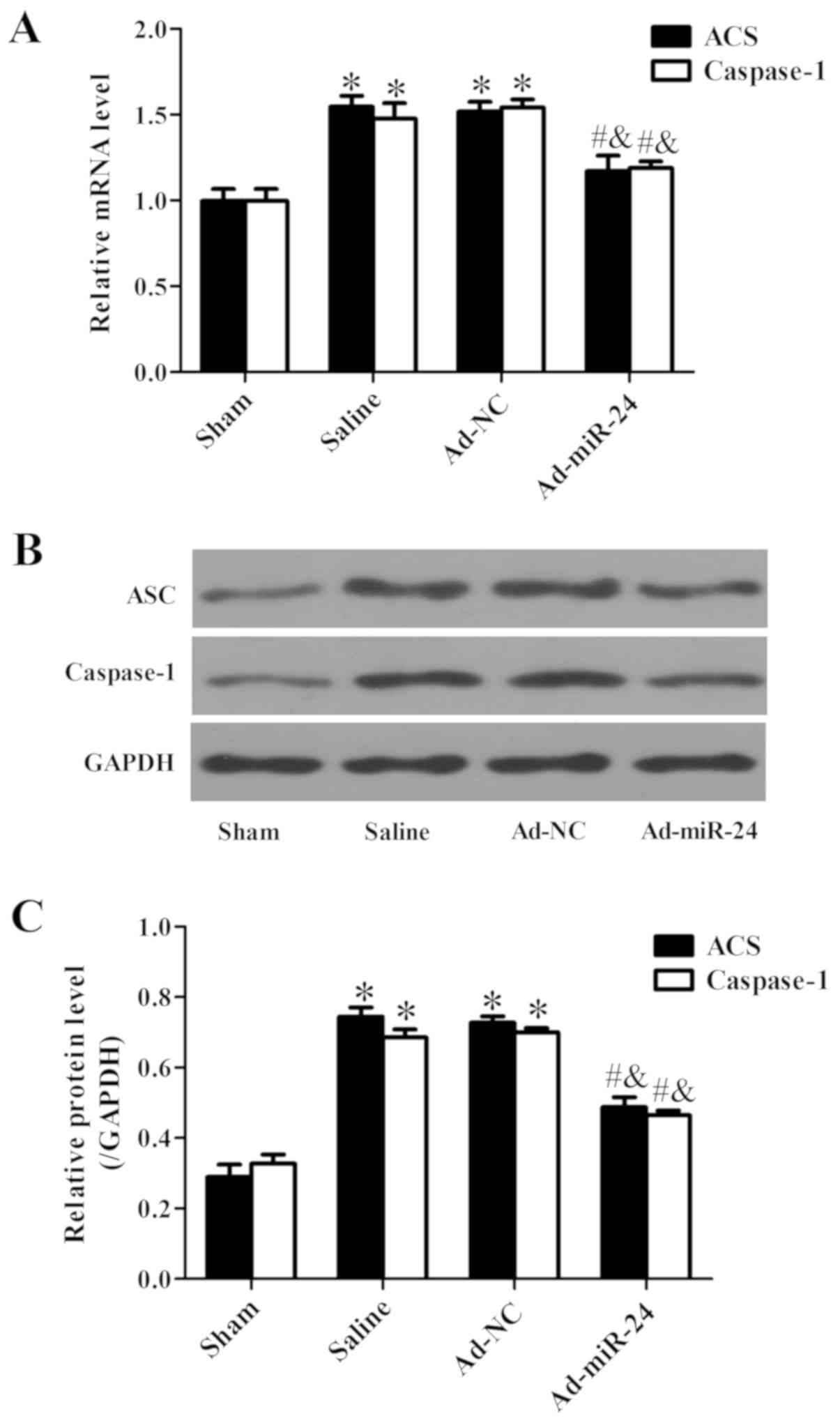|
1
|
Naito R and Miyauchi K: Coronary artery
disease and type 2 diabetes mellitus. Int Heart J. 58:475–480.
2017. View Article : Google Scholar : PubMed/NCBI
|
|
2
|
Yahagi K, Kolodgie FD, Lutter C, Mori H,
Romero ME, Finn AV and Virmani R: Pathology of human coronary and
carotid artery atherosclerosis and vascular calcification in
diabetes mellitus. Arterioscler Thromb Vasc Biol. 37:191–204. 2017.
View Article : Google Scholar
|
|
3
|
Beckman JA and Creager MA: Vascular
complications of diabetes. Circ Res. 118:1771–1785. 2016.
View Article : Google Scholar : PubMed/NCBI
|
|
4
|
Zhang WX, Tai GJ, Li XX and Xu M:
Inhibition of neointima hyperplasia by the combined therapy of
linagliptin and metformin via AMPK/Nox4 signaling in diabetic rats.
Free Radic Biol Med. 143:153–163. 2019. View Article : Google Scholar : PubMed/NCBI
|
|
5
|
Chen J, Zhang J, Yang J, Xu L, Hu Q, Xu C,
Yang S and Jiang H: Histone demethylase KDM3a, a novel regulator of
vascular smooth muscle cells, controls vascular neointimal
hyperplasia in diabetic rats. Atherosclerosis. 257:152–163. 2017.
View Article : Google Scholar : PubMed/NCBI
|
|
6
|
Suzuki J, Tezuka D, Morishita R and Isobe
M: An initial case of suppressed restenosis with nuclear
factor-kappa B decoy transfection after percutaneous coronary
intervention. J Gene Med. 11:89–91. 2009. View Article : Google Scholar
|
|
7
|
Wang Y, Zhang X, Gao L, Li J, Chen W, Chi
J, Zhang X, Fu Y, Zhao M, Liu N, et al: Cortistatin exerts
antiproliferation and antimigration effects in vascular smooth
muscle cells stimulated by Ang II through suppressing ERK1/2, p38
MAPK, JNK and ERK5 signaling pathways. Ann Transl Med. 7:5612019.
View Article : Google Scholar : PubMed/NCBI
|
|
8
|
Hao H, Gabbiani G and Bochaton-Piallat ML:
Arterial smooth muscle cell heterogeneity: Implications for
atherosclerosis and restenosis development. Arterioscler Thromb
Vasc Biol. 23:1510–1520. 2003. View Article : Google Scholar : PubMed/NCBI
|
|
9
|
Feng S, Gao L, Zhang D, Tian X, Kong L,
Shi H, Wu L, Huang Z, Du B and Liang C: MiR-93 regulates vascular
smooth muscle cell proliferation, and neointimal formation through
targeting Mfn2. Int J Biol Sci. 15:2615–2626. 2019. View Article : Google Scholar : PubMed/NCBI
|
|
10
|
Li H, Zhao J, Liu B, Luo J, Li Z, Qin X
and Wei Y: MicroRNA-320 targeting neuropilin 1 inhibits
proliferation and migration of vascular smooth muscle cells and
neointimal formation. Int J Med Sci. 16:106–114. 2019. View Article : Google Scholar : PubMed/NCBI
|
|
11
|
Lightell DJ Jr, Moss SC and Woods TC:
Upregulation of miR-221 and -222 in response to increased
extracellular signal-regulated kinases 1/2 activity exacerbates
neointimal hyperplasia in diabetes mellitus. Atherosclerosis.
269:71–78. 2018. View Article : Google Scholar :
|
|
12
|
Fan ZX and Yang J: Microribonucleic acids
and vascular restenosis. Saudi Med J. 35:796–801. 2014.PubMed/NCBI
|
|
13
|
Ren K, Zhu X, Zheng Z, Mo ZC, Peng XS,
Zeng YZ, Ou HX, Zhang QH, Qi HZ, Zhao GJ and Yi GH: MicroRNA-24
aggravates atherosclerosis by inhibiting selective lipid uptake
from HDL cholesterol via the post-transcriptional repression of
scavenger receptor class B type I. Atherosclerosis. 270:57–67.
2018. View Article : Google Scholar : PubMed/NCBI
|
|
14
|
Cai W, Zhang J and Yang J, Fan Z, Liu X,
Gao W, Zeng P, Xiong M, Ma C and Yang J: MicroRNA-24 attenuates
vascular remodeling in diabetic rats through PI3K/Akt signaling
pathway. Nutr Metab Cardiovasc Dis. 29:621–632. 2019. View Article : Google Scholar : PubMed/NCBI
|
|
15
|
Yang J, Zeng P, Yang J, Liu X, Ding J,
Wang H and Chen L: MicroRNA-24 regulates vascular remodeling via
inhibiting PDGF-BB pathway in diabetic rat model. Gene. 659:67–76.
2018. View Article : Google Scholar : PubMed/NCBI
|
|
16
|
Yang J, Fan Z, Yang J, Ding J, Yang C and
Chen L: MicroRNA-24 attenuates neointimal hyperplasia in the
diabetic rat carotid artery injury model by inhibiting wnt4
signaling pathway. Int J Mol Sci. 17:pii: E765. 2016. View Article : Google Scholar
|
|
17
|
Yang J, Chen L, Ding J, Fan Z, Li S, Wu H,
Zhang J, Yang C, Wang H, Zeng P and Yang J: MicroRNA-24 inhibits
high glucose-induced vascular smooth muscle cell proliferation and
migration by targeting HMGB1. Gene. 586:268–273. 2016. View Article : Google Scholar : PubMed/NCBI
|
|
18
|
Kim EJ, Park SY, Baek SE, Jang MA, Lee WS,
Bae SS, Kim K and Kim CD: HMGB1 increases IL-1β production in
vascular smooth muscle cells via NLRP3 Inflammasome. Front Physiol.
9:3132018. View Article : Google Scholar
|
|
19
|
Pasqua T, Pagliaro P, Rocca C, Angelone T
and Penna C: Role of NLRP-3 inflammasome in hypertension: A
potential therapeutic target. Curr Pharm Biotechnol. 19:708–714.
2018. View Article : Google Scholar : PubMed/NCBI
|
|
20
|
Wang R, Wu W, Li W, Huang S, Li Z, Liu R,
Shan Z, Zhang C, Li W and Wang S: Activation of NLRP3 inflammasome
promotes foam cell formation in vascular smooth muscle cells and
atherogenesis Via HMGB. J Am Heart Assoc. 7:e0085962018. View Article : Google Scholar
|
|
21
|
Ren XS, Tong Y, Ling L, Chen D, Sun HJ,
Zhou H, Qi XH, Chen Q, Li YH, Kang YM and Zhu GQ: NLRP3 gene
deletion attenuates angiotensin II-Induced phenotypic
transformation of vascular smooth muscle cells and vascular
remodeling. Cell Physiol Biochem. 44:2269–2280. 2017. View Article : Google Scholar : PubMed/NCBI
|
|
22
|
Sun HJ, Ren XS, Xiong XQ, Chen YZ, Zhao
MX, Wang JJ, Zhou YB, Han Y, Chen Q, Li YH, et al: NLRP3
inflammasome activation contributes to VSMC phenotypic
transformation and proliferation in hypertension. Cell Death Dis.
8:e30742017. View Article : Google Scholar : PubMed/NCBI
|
|
23
|
Lin Y and Yang Y: miR-24 inhibits
inflammatory responses in LPS-induced acute lung injury of neonatal
rats through targeting NLRP3. Pathol Res Pract. 215:683–688. 2019.
View Article : Google Scholar : PubMed/NCBI
|
|
24
|
Bayne K: Revised guide for the care and
use of laboratory animals available american physiological society.
Physiologist. 39:199208–211. 1996.
|
|
25
|
Yang J, Jiang H, Chen SS, Chen J, Li WQ,
Xu SK and Wang JC: Lentivirus-mediated RNAi targeting CREB binding
protein attenuates neointimal formation and promotes
re-endothelialization in balloon injured rat carotid artery. Cell
Physiol Biochem. 26:441–448. 2010. View Article : Google Scholar : PubMed/NCBI
|
|
26
|
Khuman MW, Harikumar SK, Sadam A, Kesavan
M, Susanth VS, Parida S, Singh KP and Sarkar SN: Candesartan
ameliorates arsenic-induced hypertensive vascular remodeling by
regularizing angiotensin II and TGF-beta signaling in rats.
Toxicology. 374:29–41. 2016. View Article : Google Scholar : PubMed/NCBI
|
|
27
|
Livak KJ and Schmittgen TD: Analysis of
relative gene expression data using real-time quantitative PCR and
the 2(−Delta Delta C(T)) method. Methods. 25:402–408. 2001.
View Article : Google Scholar
|
|
28
|
Bednarska J, Bednarska-Chabowska D and
Adamiec-Mroczek J: Coronary artery disease: New insights into
revascularization treatment of diabetic patients. Adv Clin Exp Med.
26:1163–1167. 2017.PubMed/NCBI
|
|
29
|
Wang JL, Qin Z, Wang ZJ, Shi DM, Liu YY,
Zhao YX, Yang LX, Cheng WJ and Zhou YJ: New predictors of in-stent
restenosis in patients with diabetes mellitus undergoing
percutaneous coronary intervention with drug-eluting stent. J
Geriatr Cardiol. 15:137–145. 2018.PubMed/NCBI
|
|
30
|
Zheng Y, Li Y, Liu G, Qi X and Cao X:
MicroRNA-24 inhibits the proliferation and migration of endothelial
cells in patients with atherosclerosis by targeting importin-α3 and
regulating inflammatory responses. Exp Ther Med. 15:338–344.
2018.
|
|
31
|
Fiedler J, Stöhr A, Gupta SK, Hartmann D,
Holzmann A, Just A, Hansen A, Hilfiker-Kleiner D, Eschenhagen T and
Thum T: Functional microRNA library screening identifies the
hypoxamir miR-24 as a potent regulator of smooth muscle cell
proliferation and vascularization. Antioxid Redox Signal.
21:1167–1176. 2014. View Article : Google Scholar :
|
|
32
|
Chan MC, Hilyard AC, Wu C, Davis BN, Hill
NS, Lal A, Lieberman J, Lagna G and Hata A: Molecular basis for
antagonism between PDGF and the TGFbeta family of signalling
pathways by control of miR-24 expression. EMBO J. 29:559–573. 2010.
View Article : Google Scholar
|
|
33
|
Durham AL, Speer MY, Scatena M, Giachelli
CM and Shanahan CM: Role of smooth muscle cells in vascular
calcification: Implications in atherosclerosis and arterial
stiffness. Cardiovasc Res. 114:590–600. 2018. View Article : Google Scholar : PubMed/NCBI
|
|
34
|
Wang D and Atanasov AG: The microRNAs
regulating vascular smooth muscle cell proliferation: A Minireview.
Int J Mol Sci. 20:Pii: E324. 2019.
|
|
35
|
Jo EK, Kim JK, Shin DM and Sasakawa C:
Molecular mechanisms regulating NLRP3 inflammasome activation. Cell
Mol Immunol. 13:148–159. 2016. View Article : Google Scholar :
|
|
36
|
Whiteford JR, De Rossi G and Woodfin A:
Mutually supportive mechanisms of inflammation and vascular
remodeling. Int Rev Cell Mol Biol. 326:201–278. 2016. View Article : Google Scholar : PubMed/NCBI
|
|
37
|
Lu QB, Wan MY, Wang PY, Zhang CX, Xu DY,
Liao X and Sun HJ: Chicoric acid prevents PDGF-BB-induced VSMC
dedifferentiation, proliferation and migration by suppressing
ROS/NFκB/mTOR/P70S6K signaling cascade. Redox Bio. 114:656–668.
2018. View Article : Google Scholar
|
|
38
|
Li FJ, Zhang CL, Luo XJ, Peng J and Yang
TL: Involvement of the MiR-181b-5p/HMGB1 pathway in ang II-induced
phenotypic transformation of smooth muscle cells in hypertension.
Aging Dis. 10:231–248. 2019. View Article : Google Scholar : PubMed/NCBI
|
|
39
|
Jansen F, Zietzer A, Stumpf T, Flender A,
Schmitz T, Nickenig G and Werner N: Endothelial
microparticle-promoted inhibition of vascular remodeling is
abrogated under hyperglycaemic conditions. J Mol Cell Cardiol.
112:91–94. 2017. View Article : Google Scholar : PubMed/NCBI
|
|
40
|
Chang HK, Kim PH, Kim DW, Cho HM, Jeong
MJ, Kim DH, Joung YK, Lim KS, Kim HB, Lim HC, et al: Coronary
stents with inducible VEGF/HGF-secreting UCB-MSCs reduced
restenosis and increased re-endothelialization in a swine model.
Exp Mol Med. 50:1142018. View Article : Google Scholar : PubMed/NCBI
|
|
41
|
Zhang J, Cai W, Fan Z, Yang C, Wang W,
Xiong M, Ma C and Yang J: MicroRNA-24 inhibits the oxidative stress
induced by vascular injury by activating the Nrf2/Ho-1 signaling
pathway. Atherosclerosis. 290:9–18. 2019. View Article : Google Scholar : PubMed/NCBI
|















